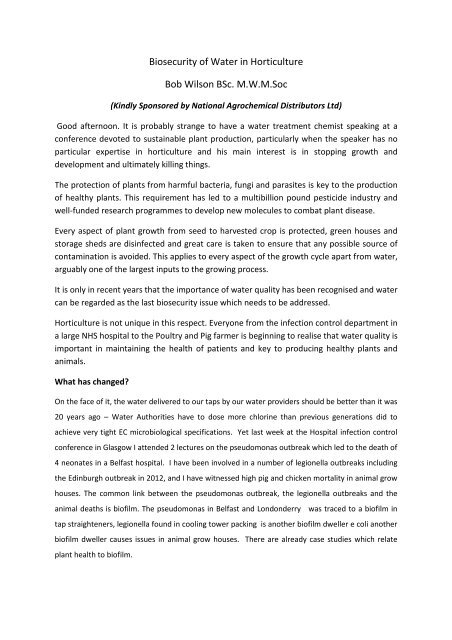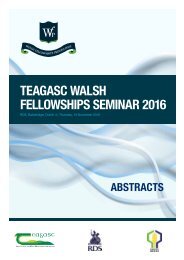1vI0JGB
1vI0JGB
1vI0JGB
Create successful ePaper yourself
Turn your PDF publications into a flip-book with our unique Google optimized e-Paper software.
Biosecurity of Water in Horticulture<br />
Bob Wilson BSc. M.W.M.Soc<br />
(Kindly Sponsored by National Agrochemical Distributors Ltd)<br />
Good afternoon. It is probably strange to have a water treatment chemist speaking at a<br />
conference devoted to sustainable plant production, particularly when the speaker has no<br />
particular expertise in horticulture and his main interest is in stopping growth and<br />
development and ultimately killing things.<br />
The protection of plants from harmful bacteria, fungi and parasites is key to the production<br />
of healthy plants. This requirement has led to a multibillion pound pesticide industry and<br />
well-funded research programmes to develop new molecules to combat plant disease.<br />
Every aspect of plant growth from seed to harvested crop is protected, green houses and<br />
storage sheds are disinfected and great care is taken to ensure that any possible source of<br />
contamination is avoided. This applies to every aspect of the growth cycle apart from water,<br />
arguably one of the largest inputs to the growing process.<br />
It is only in recent years that the importance of water quality has been recognised and water<br />
can be regarded as the last biosecurity issue which needs to be addressed.<br />
Horticulture is not unique in this respect. Everyone from the infection control department in<br />
a large NHS hospital to the Poultry and Pig farmer is beginning to realise that water quality is<br />
important in maintaining the health of patients and key to producing healthy plants and<br />
animals.<br />
What has changed<br />
On the face of it, the water delivered to our taps by our water providers should be better than it was<br />
20 years ago – Water Authorities have to dose more chlorine than previous generations did to<br />
achieve very tight EC microbiological specifications. Yet last week at the Hospital infection control<br />
conference in Glasgow I attended 2 lectures on the pseudomonas outbreak which led to the death of<br />
4 neonates in a Belfast hospital. I have been involved in a number of legionella outbreaks including<br />
the Edinburgh outbreak in 2012, and I have witnessed high pig and chicken mortality in animal grow<br />
houses. The common link between the pseudomonas outbreak, the legionella outbreaks and the<br />
animal deaths is biofilm. The pseudomonas in Belfast and Londonderry<br />
was traced to a biofilm in<br />
tap straighteners, legionella found in cooling tower packing is another biofilm dweller e coli another<br />
biofilm dweller causes issues in animal grow houses.<br />
plant health to biofilm.<br />
There are already case studies which relate




